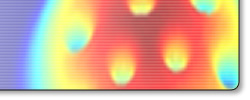ACQAO Theorists Work Suggested by the Editors of Physical Review Letters
8 July 2010
In a recent Editor Suggested Physical Review Letter [PRL 105, 013201 (2010)], Swinburne-ACQAO theorist Chris Ticknor (now back in the USA at Los Alamos National Laboratory) along with Seth Rittenhouse of ITAMP (the Institute for Theoretical Atomic, Molecular and Optical Physics at Harvard-Smithsonian Center for Astrophysics) theoretically studied three-body recombination in a dilute system of dipoles. This is when three particles interact resulting in two particles forming a molecule and the third particle carrying away the binding energy in the form of kinetic energy. Such a process has proven to be one of the important factors in determining the lifetime of an ultracold gas. In contrast to typical ultracold gases whose interactions are essentially zero range and isotropic, the dipole-dipole interaction is strong and long range. This interaction will lead to the study of strongly interacting and highly correlated systems in the ultracold environment, offering insight into correlated quantum systems such as superconductors.
First, the authors showed that the structure of bound states in a two-body dipolar system depends only on the ratio of s-wave scattering length (a) and dipole length scale (D), when D is large. When this ratio is known, the structure of the bound states (e.g., shape and size) is the same no matter what specific system is being considered. The results show the standard halo dimers at large a/D but a novel and universal short range molecule at small a/D.
With the properties of these two-body bound states known, the researchers found how a third particle can collide with two others to form one of these molecules. The trick becomes how to express the long range, anisotropic interaction between all three particles. This was done by using a bi-harmonic expansion, similar to calculations in helium when the electron-electron interaction is expanded in the basis defined by the proton. This allows the interaction between the two dipoles in the molecule and the third to be accounted for, while using the two-body molecular eigenstate to account for the interaction of the molecular pair.
Finally, to extract the scaling behavior of the three-body recombination rate as a function of the scattering length (a/D), a Fermi Golden Rule calculation was performed. This determines how likely a three-body recombination process is by finding the overlap of the incident three-particle plane wave with the final molecular state and the energetic continuum state. The result is that at large a/D the rate scales at (a/D)^4, like ultracold atoms with large scattering length. Then when a/D is small, the rate becomes independent of a/D. This is important when systems have large dipole-dipole interactions because it offers an estimate of how readily molecules will form and limits the lifetime of the gas.
To find out more:
http://link.aps.org/doi/10.1103/PhysRevLett.105.013201 |

